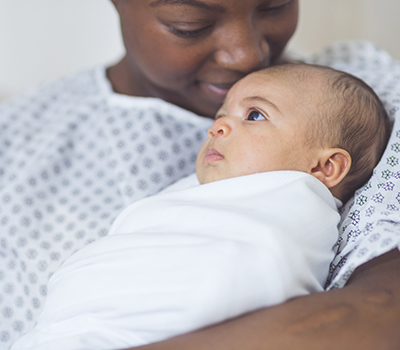Interrupting the Mother-ChildDyad is Not the Answer to Infant Safety
 Over the past decade, hospitals across the country have increasingly moved away from the traditional use of nurseries for healthy newborn infants, choosing instead for babies to “room-in” with mothers so that they are kept together throughout their hospitalization. Among many health benefits to both mom and baby, rooming-in supports mother-child bonding, encourages skin-to-skin contact—which can help soothe babies and support breastfeeding—increases exclusive breastfeeding rates, and offers a safe environment for mothers to learn and practice caring for their brand new baby.
Over the past decade, hospitals across the country have increasingly moved away from the traditional use of nurseries for healthy newborn infants, choosing instead for babies to “room-in” with mothers so that they are kept together throughout their hospitalization. Among many health benefits to both mom and baby, rooming-in supports mother-child bonding, encourages skin-to-skin contact—which can help soothe babies and support breastfeeding—increases exclusive breastfeeding rates, and offers a safe environment for mothers to learn and practice caring for their brand new baby.
Now, new research from a study published in Pediatrics suggests that rooming-in, as well as skin-to-skin care, has the potential to increase breastfeeding rates among African-American mothers specifically, a population that has the lowest rates of breastfeeding among racial and ethnic groups.
NAPPSS-IIN is an initiative to make infant safe sleep and breastfeeding the national norm. Learn more about the work here.
“It’s the first time that rooming-in, in particular, has been identified as a strategy to reduce the rate of disparities in breastfeeding initiation and continuation,” confirms Lori Feldman-Winter, MD, MPH, one of the authors on the study, and a Co-Chair on the NICHQ-led National Action Partnership to Promote Safe Sleep Improvement and Innovation Network (NAPPSS-IIN).
These findings signify that rooming-in not only has the potential to improve health outcomes for moms and babies, but it is a critical strategy for closing cultural gaps in breastfeeding and, in turn, gaps in maternal and infant health.
Recently though, questions about infant safety and rooming-in have arisen due to worries that an already exhausted mother may fall asleep while breastfeeding her baby, which can result in infant falls, accidents, and injury.
Addressing infant safety is critical, says Feldman-Winter, “But solutions should not start with separating a mother from her child.”
“When we separate mothers from their babies, we inadvertently blame the mother—she is the risk that is removed. Instead, we need to start with the knowledge that a mother should be with her baby, that this is natural, instinctual, incredibly beneficial, and what most mirrors their home environment. If we start there, we can then consider what processes to change and embrace within the healthcare system to mitigate risks while keeping mom and baby together.”
By adapting their processes to encourage safe rooming-in, hospitals can help more mothers and babies benefit from this critical practice, one that makes an important contribution to health equity. Below, Feldman-Winter and two representatives from the Association of Women’s Health Obstetric and Neonatal Nurses (AWHONN) offer solutions on where to start.
Solutions that Support Safe Rooming-In
Adequate staffing
Appropriate staffing goes a long way toward establishing a safe environment, especially in those first days after delivery when every experience is new. Frequent rounding by nurses helps mothers get the support they need whenever they need it, especially when breastfeeding; and a systematic process for hand-off and reporting between staff during shift changes can help ensure no interruptions in care or communication breakdowns.
Similarly, explains Sharon Hitchcock, DNP, RN-C, AWHONN’s representative to NAPPSS-IIN, staffing ratios should adjust for mothers who may be more at risk of falling asleep while breastfeeding or holding their baby.
“Mothers who had a cesarean section and are on narcotics; mothers who suffered from preeclampsia or are sick in other ways; and mothers who are more sedated or have different risk factors for exhaustion—policies need to account for these higher risk situations to support appropriate staffing ratios,” says Hitchcock. “Too often though, staffing ratios aren’t adjusted to reflect these needs.”
To promote safer rooming-in care, hospitals should begin by reviewing AWHONN’s staffing guidelines explains Catherine Ruhl, MS, CNM, AWHONN’s Director of Women’s Health Programs.
“The guidelines for perinatal, mother-baby, and postpartum units are very specific, walking hospitals through every step of appropriate staffing, with recommendations based on whether a mother underwent a cesarean birth or has had complications.”
Improved education
Even with the right ratios, there can be a breakdown in care if maternal health professionals aren’t offered adequate training on supporting infant safety while moms are rooming-in and breastfeeding.
“There often times isn’t enough education for staff about the risks for falls,” says Hitchcock. “And without that education, nurses won’t know what to monitor when they’re with moms. We need to pursue every opportunity to update rooming-in and breastfeeding guidelines with a safety focus, and make sure those guidelines are taught at all birthing hospitals.”
Better staff education also translates to better education for families. When babies stay with their mothers, families are given a unique opportunity to practice caring for their newborn in a safe environment. Hospital staff, who are critical to this learning period, can help model safe behaviors, such as how to safely hold a baby to support skin-to-skin contact and safely breastfeed. With this, rooming-in offers a vital window for preventing future risky behaviors.
Education should also support and empower the mother’s support system, adds Feldman-Winter. By bringing family members and partners to the table, discussing their role in helping mom and baby stay safe, and teaching them about safe behaviors, maternal health professionals can help ensure a smoother transition home.
A culture that supports change
Many hospitals only recently transitioned or are the process of transitioning away from nursery-style care. And with change comes natural resistance.
“Any systems-change effort requires a culture shift,” says Feldman-Winter. “We’re asking people to change their practice and that can engender push-back and, sometimes, the unintended consequence of less optimal care and accidents. We need to be careful not to blame mothers for falls that might stem from a shift in practice.”
Raising awareness about the benefits of rooming-in, posting data and big-impact facts about rooming-in in public areas, identifying hospital champions who will spread the word among their peers, and putting structures in place for accountability can all help hospitals adopt a culture of change.
“For nearly a decade, rooming-in has been a critical strategy in NICHQ’s work to increase breastfeeding rates, from national efforts like Best Fed Beginnings and NAPPSS-IIN to regional work in New York State and Texas,” says NICHQ Executive Project Director Pat Heinrich. RN, MSC, CLE. “Now that we’re seeing it support African-American populations specifically, its potential as a catalyst for change has only increased. By helping hospitals and states advance policies and processes that account for risks, we can help more moms and babies stay together safely and have the best outcomes possible.”
